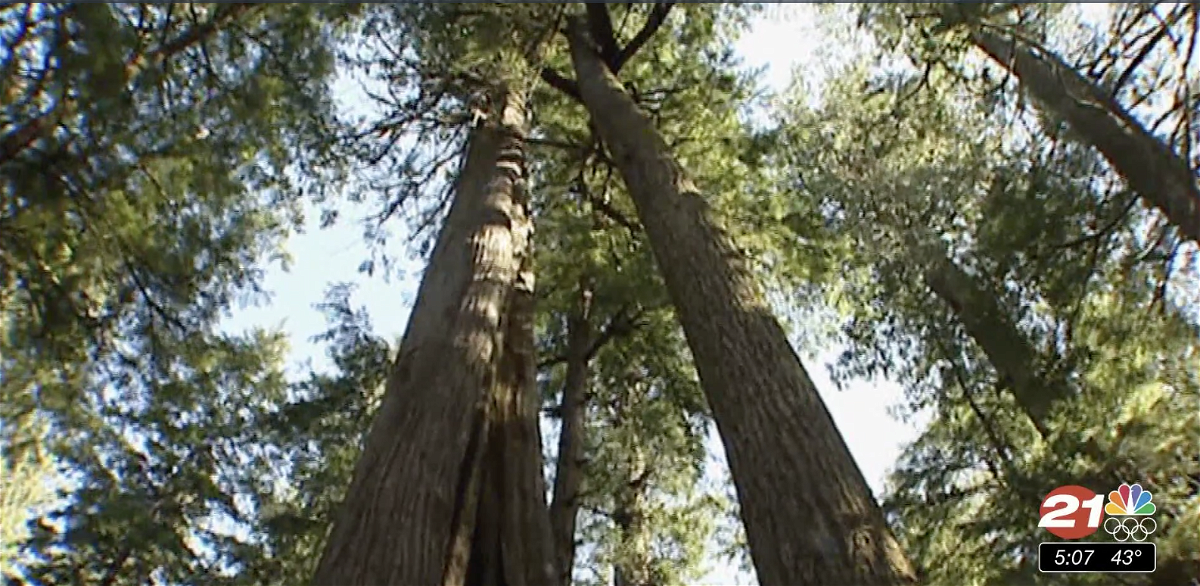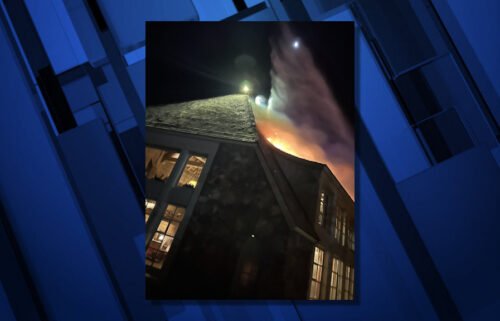President Biden, in Seattle on Earth Day, signing order to protect old-growth forests from wildfire

By MATTHEW DALY and JOSH BOAK
AP Staff Writers
SEATTLE (AP) — President Joe Biden is taking steps to restore national forests that have been devastated by wildfires, drought and blight, using an Earth Day visit to Seattle to sign an executive order protecting some of the nation’s largest and oldest trees.
Old-growth trees are key buffers against climate change and provide crucial carbon sinks that absorb significant amounts of carbon dioxide and other greenhouse gases that contribute to global warming.
Biden’s order directs federal land managers to define and inventory mature and old-growth forests nationwide within a year. The order requires the Forest Service, the Bureau of Land Management and the National Park Service to identify threats to older trees, such as wildfire and climate change, and develop policies to safeguard them.
The order does not ban logging of mature or old-growth trees, the White House said.
By signing the order on Friday, Biden can publicly reassert his environmentalist credentials at a time when his administration has been preoccupied by high oil and gasoline prices following Russia’s invasion of Ukraine. Gas costs have been a drag on Biden’s popularity and created short-term political pressures going into this year’s midterm elections, yet the Democratic president has been focused on wildfires that are intensifying because of climate change.
The measure is intended to safeguard national forests that been severely damaged by wildfires, drought and blight, including recent fires that killed thousands of giant sequoias in California. Redwood forests are among the world’s most efficient at removing and storing carbon dioxide in the atmosphere and provide critical habitat for native wildlife and watersheds that supply farms and communities in the West.
Blazes so intense to kill trees once considered virtually fire-proof have alarmed land managers, environmentalists and tree lovers the world over — and demonstrated the grave impacts of climate change. A warming planet that has created longer and hotter droughts, combined with a century of fire suppression that choked forests with thick undergrowth, has fueled flames that extinguished trees dating to ancient civilizations.
A senior administration official noted that forests absorb more than 10% of U.S. annual greenhouse gases, while also providing flood control, clean water, clear air and a home to wildlife. The official insisted on anonymity to discuss details of Biden’s order before it was made public.
Biden’s ambitious climate agenda has been marred by setbacks, a year after he took office amid a flurry of climate-related promises. The president hosted a virtual summit on global warming at the White House last Earth Day. He used the moment to nearly double the United States’ goal for reducing greenhouse gas emissions, vaulting the country to the front lines in the fight against climate change.
A year later, his most sweeping proposals remain stalled on Capitol Hill despite renewed warnings from scientists that the world is hurtling toward a dangerous future marked by extreme heat, drought and weather.
In addition, Russia’s war in Ukraine has reshuffled the politics of climate change, leading Biden to release oil from the nation’s strategic reserve and encourage more domestic drilling in hopes of lowering sky-high gas prices that are emptying American wallets.
While Biden is raising fuel economy standards for vehicles and included green policies in last year’s bipartisan infrastructure law, the lack of greater progress casts a shadow over his second Earth Day as president.
Timber industry representative Nick Smith said before the order was made public that loggers are worried it will add more bureaucracy to a forest management framework already unable to keep up with growing wildfires due to climate change.
That would undercut the Biden administration’s goal of doubling the amount of logging and controlled burns over the next decade to thin forests in the tinder-dry West, said Smith, a spokesman for the American Forest Resource Council, an Oregon-based industry group.
“The federal government has an urgent need to reduce massive greenhouse gas emissions from severe wildfires, which can only be accomplished by actively managing our unhealthy and overstocked federal forests,” he said.
But former U.S. Forest Service Deputy Chief Jim Furnish said wildfire risks and climate change would be better addressed by removing smaller trees that can fuel uncontrolled blazes, while leaving mature trees in place.
For many years the Forest Service allowed older trees that are worth more to be logged, to bring in money for removal of smaller trees, Furnish said. But that’s no longer necessary after Congress approved more than $5 billion to reduce wildfire risks in last year’s infrastructure bill, he said. The law includes money to hire 1,500 firefighters and ensure they earn at least $15 an hour.
Timber sales from federal forests nationwide more than doubled over the past 20 years, as Republicans and Democrats have pushed more aggressive thinning of stands to reduce small trees and vegetation that fuel wildfires.
Critics, including many forest scientists, say officials are allowing removal of too many older trees that can withstand fire.
A letter signed by 135 scientists called on Biden to protect mature and old-growth forests as a critical climate solution.
“Older forests provide the most above-ground carbon storage potential on Earth, with mature forests and larger trees driving most accumulation of forest carbon in the critical next few decades. Left vulnerable to logging, though, they cannot fulfill these vital functions,″ the scientists wrote Thursday. Former Forest Service Chief Mike Dombeck and Norman Christensen, founding dean and professor emeritus at Duke University’s Nicholas School of the Environment, were among those signing the letter.
Protecting mature forests also “would set an important, highly visible example for other major forest-holding nations to follow as they address climate change threats,″ the scientists wrote.
___
Associated Press writer Matthew Brown in Billings, Montana, contributed to this story.
White House news release:
FACT SHEET: President Biden Signs Executive Order to Strengthen America’s Forests, Boost Wildfire Resilience, and Combat Global Deforestation
APRIL 22, 2022•STATEMENTS AND RELEASES
New actions will protect against wildfire threats, support local economies, and reduce climate pollution
Today, on Earth Day, President Biden will sign an Executive Order to expand his Administration’s historic and bold efforts to tackle the climate crisis, make our nation more resilient to extreme weather, and strengthen local economies. The President will sign the Executive Order in Seattle, Washington—rounding out a trip across the West focused on lowering costs for families and protecting communities from intensifying climate impacts. Wildfires and extreme weather events are growing in frequency and ferocity, engulfing communities in the West and across the country and costing lives, homes, and money. Because President Biden knows the cost of inaction is too great, he is taking bold executive action and reaffirming his calls on Congress to address the climate crisis.
America’s forests are a key climate solution, absorbing carbon dioxide equivalent to more than 10% of U.S. annual greenhouse gas emissions. Federal lands are home to many of the nation’s mature and old-growth forests, which serve as critical carbon sinks, cherished landscapes, and unique habitats. However, these magnificent ecosystems are threatened by the climate impacts that are already here, with intensifying wildfires demanding urgent action to protect our forests and the economies that depend on them. The Bipartisan Infrastructure Law provides historic wildfire resilience funding and calls for prioritizing the restoration of old-growth forests.
Building on this directive and the Administration’s commitment to climate-smart forest stewardship, today’s Executive Order will:
- Safeguard mature and old-growth forests on federal lands, as part of a science-based approach to reduce wildfire risk.
- Strengthen reforestation partnerships across the country to support local economies and ensure we retain forest ecosystems and sustainable supplies of forest products for years to come.
- Combat global deforestation to deliver on key COP26 commitments.
- Enlist nature to address the climate crisis with comprehensive efforts to deploy nature-based solutions that reduce emissions and build resilience.
Across these efforts, the Administration will leverage historic investments from the Bipartisan Infrastructure Law and the FY 2022 budget, and work in partnership with states, Tribal Nations, communities, industry, NGOs, labor, scientists, and private landowners, to strengthen our forests while creating good-paying jobs.
Today’s Executive Order will advance the Biden-Harris Administration’s climate goals and economic agenda by:
Reducing Wildfire Risk
Under President Biden’s leadership, the U.S. Department of Agriculture’s (USDA) Forest Service has developed a 10-year strategy to reduce wildfire risk through science-based fuels and forest health treatments, with a goal of treating an additional 50 million acres across federal and non-federal lands. The Department of the Interior (DOI) has also developed a 5-year plan for monitoring, maintenance, and treatment efforts focused on fire-prone Interior and Tribal lands.
As a critical down payment, the Bipartisan Infrastructure Law provides $8 billion to fund forest and land management activities, and the FY 2022 Omnibus provides $5.7 billion for wildland fire management and related risk mitigation and research. USDA and DOI are mobilizing $5 billion from the Bipartisan Infrastructure Law for hazardous fuels reduction and other mitigation programs, such as a $1 billion Community Wildfire Defense Grant program and $600 million for firefighter pay—providing about 1,500 additional firefighters and supporting the President’s commitment that no federal firefighter will make less than $15 an hour. Already, USDA has announced $131 million this year for wildfire risk reduction treatments in high-risk landscapes in Washington, Oregon, California, Idaho, Montana, Colorado, New Mexico, and Arizona.
The Bipartisan Infrastructure Law directs DOI and USDA to specifically prioritize the restoration of old-growth forests, taking into consideration their contributions to landscape fire adaptation. However, there is currently no inventory that identifies the location and condition of mature and old-growth stands.
To strengthen America’s forests and advance a holistic, science-based approach to wildfire resilience and forest restoration, this Executive Order advances action on:
- Data Collection and Analysis: DOI and USDA will conduct the first-ever inventory of mature and old-growth forests on federal lands. This will be completed and made publicly available in a year and will establish consistent definitions, accounting for regional and ecological variation. The agencies will then analyze threats facing these forests, including from wildfires and other climate impacts.
- Climate-Smart Stewardship: After completing the inventory, DOI and USDA will develop new policies, with robust opportunity for public comment, to institutionalize climate-smart management and conservation strategies that address the threats facing mature and old-growth forests on federal lands.
- Enhanced Coordination: DOI and USDA will partner with other federal agencies, states, Tribal Nations, and any interested private landowners to better coordinate conservation and wildfire risk reduction efforts—leveraging investments from the Bipartisan Infrastructure Law and other sources.
Going forward, the Administration will work with Congress to secure additional resources, by requesting $6.1 billion for wildfire risk reduction in the President’s FY 2023 Budget and continuing to pursue historic climate resilience investments in additional legislation.
Strengthening Forests for Thriving Local Economies
America’s forests provide millions of jobs and underpin local economies, particularly in rural communities. The Biden-Harris Administration is mobilizing historic resources to help these forests and communities thrive. For example, the Administration’s Building a Better America Rural Infrastructure Tour is highlighting wide-ranging support for healthy forest economies, including: planning assistance to boost outdoor recreation economies; support for Tribes, local governments, and conservation non-profits to establish community forests that create jobs; and grants to expand markets for innovative wood products and wood energy that support sustainable forest management.
Through the FY 2022 Omnibus, the Administration is also investing $162 million in cooperative forestry programs across State, municipal, and privately-owned forest landscapes. Additionally, the Bipartisan Infrastructure Law significantly expands reforestation projects on National Forest land—enough to plant an estimated 1.2 billion trees and sequester 75 million metric tons of carbon, all while supporting thousands of jobs.
The Executive Order will build on these efforts by advancing:
- Economic Opportunities in Outdoor Recreation and Sustainable Forest Products: The Departments of Agriculture, Commerce, and the Interior will work with state, local, Tribal, and territorial governments, as well as the private sector, nonprofit organizations, labor unions, and the scientific community, to advance forest-related economic opportunities at the local and regional levels. These community-led opportunities will create and sustain jobs in outdoor recreation and in sustainable wood, paper, and other forest products, while supporting healthy, sustainably managed forests in timber communities.
- Reforestation Partnerships: The Administration will develop agency-specific 2030 targets for reforestation, including the use of partnerships to advance these goals beyond federal lands to enable our future forests to be more resilient to climate change and wildfire, while also supporting healthy forest economies for years to come.
- Expanding Seed and Nursery Capacity: USDA and DOI will address a longstanding seed shortfall by developing a plan, in partnership with states, Tribes, and the private sector, to boost federal cone and seed collection and seedling nursery capacity. These actions will support tree-planting efforts by a range of public and private partners. Expanding seed and nursery capacity is especially important for timberlands in the West that have been devastated by wildfire and need to be re-planted.
Combatting Global Deforestation
President Biden has committed to help deliver on global goals to end natural forest loss by 2030, while restoring at least an additional 200 million hectares of forests and other ecosystems. At the COP26 international climate conference, President Biden announced the “Plan to Conserve Global Forests: Critical Carbon Sinks”—harnessing U.S. diplomatic, policy, and financing tools, in partnership with other countries, Indigenous and local forest communities, the private sector, and civil society, and with a focus on three critical areas of global importance: the Amazon, Congo, and Southeast Asian forests.
To further advance these efforts and achieve the President’s international commitments, this Executive Order directs the Department of State, in coordination with other agencies, to prepare reports to the President on whole-of-government approaches to stopping global deforestation and restoring lands, including:
- Combat Commodity-Driven Deforestation: A major driver of global deforestation is forest clearing to produce agricultural commodities like beef, soy, and palm oil. To combat those practices, the Department of State will lead development of a report on whole-of-government approaches to reduce or eliminate U.S. purchases of agricultural commodities grown on illegally or recently deforested lands, including through public-private partnerships to incentivize sustainable sourcing. These efforts will not only protect forests and human rights abroad, but also provide a level playing field for responsible agricultural producers at home.
- Support Sustainable Forest Management Around the World: The Department of State will coordinate with other agencies to assess the broader use of foreign assistance, trade tools, finance, and international partnerships to combat deforestation and support sustainable forest management around the world, with special attention to the critical role played by Indigenous peoples and local communities and landholders in conserving and restoring forests.
Enlisting Nature in the Fight Against Climate Change
The Biden-Harris Administration has led the way on enhancing nature’s ability to support the health, wellbeing, and economic security of all Americans. President Biden launched the America the Beautiful initiative to support his goal of conserving at least 30 percent of U.S. lands and waters by 2030. Interagency Working Groups reporting to the National Climate Task Force are exploring nature-based solutions to address extreme heat, drought, wildfire, flood, and coastal threats. The Administration is also recognizing the value of and elevating Indigenous Traditional Ecological Knowledge across federal scientific and policy processes. The President’s Bipartisan Infrastructure Law provides—as part of over $50 billion in historic resilience investments—funding for nature-based solutions, including $2.3 billion for the Forest Service and Interior to advance ecosystem restoration and resilience.
To facilitate use of these and other resources, today the National Climate Task Force’s Coastal Resilience Interagency Working Group, co-led by the White House Council on Environmental Quality and the National Oceanic and Atmospheric Administration, is releasing a Compendium of Federal Nature-Based Solutions for Coastal Communities, States, Tribes, and Territories—streamlining access to more than 100 information resources and 48 federal programs that can support nature-based solutions in coastal areas.
To further amplify the power of nature, including its ability to absorb climate pollution and increase resilience in all communities, today’s Executive Order calls for the following:
- Report on Nature-Based Solutions: As reaffirmed this year by the Intergovernmental Panel on Climate Change, nature-based solutions will play a key role in achieving net-zero emissions and building resilience to climate impacts. Building on ongoing efforts, the White House Council on Environmental Quality, Office of Science and Technology Policy (OSTP), and Office of Domestic Climate Policy will work with agencies to develop a report to the National Climate Task Force on key opportunities for greater deployment of nature-based solutions—everything from restoring marshes, to planting shade trees, to promoting drought-resistant crops.
- Guidance on Valuing Nature: The Office of Management and Budget will issue valuation guidance to help agencies better account for services provided by ecosystems and the environment (such as pollinators supporting our crops, or forests cleaning our air and water). In support, OSTP and the Department of Commerce will continue leading an interagency initiative to improve and update baseline information on the economic value of our existing natural assets and new nature-based solutions.
- First U.S. National Nature Assessment: The United States lacks comprehensive knowledge of the state of our nation’s lands, waters, and wildlife and the specific benefits that they provide. To create this comprehensive picture, the 13-agency U.S. Global Change Research Program will develop the first-ever assessment of the condition of nature within the United States. The assessment will also allow us to look ahead at how nature might change in the future and identify opportunities for investments in nature to help achieve our climate, health, environmental justice, and economic goals.



